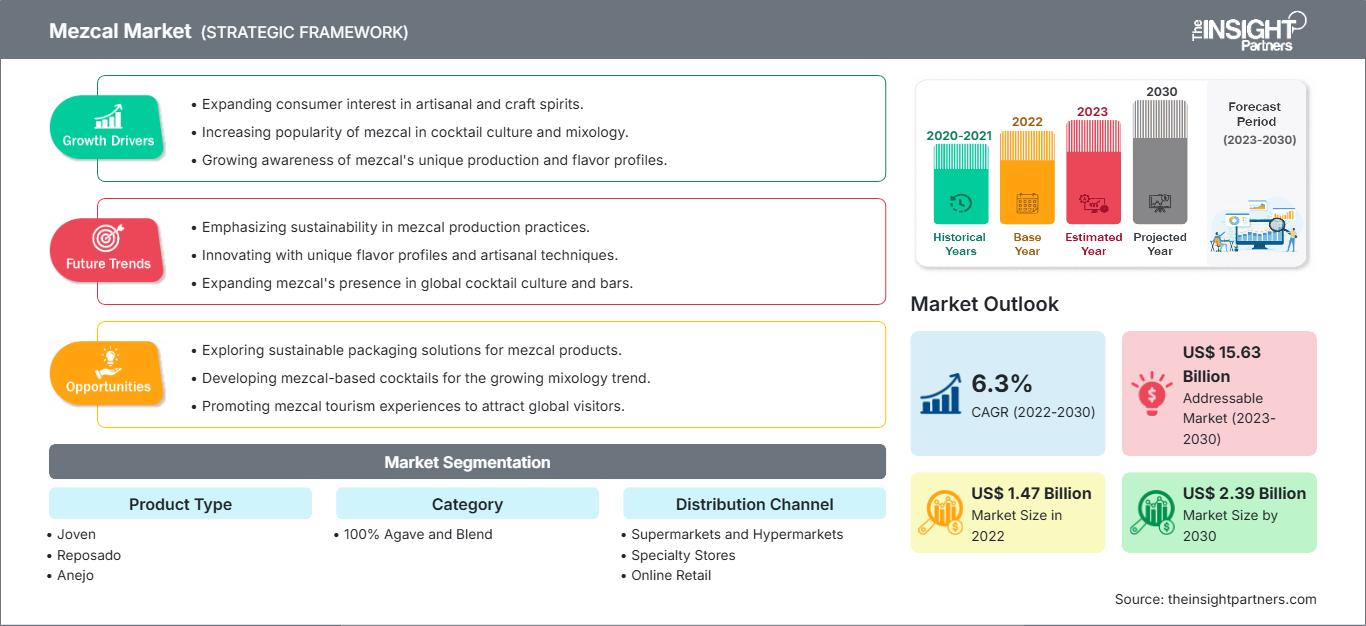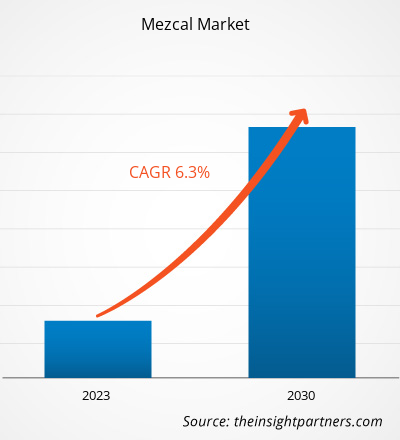Der Mezcal-Markt hatte im Jahr 2022 ein Volumen von 1.469,17 Millionen US-Dollar und soll bis 2030 2.393,57 Millionen US-Dollar erreichen; von 2022 bis 2030 wird mit einer durchschnittlichen jährlichen Wachstumsrate von 6,3 % gerechnet.
Markteinblicke und Analystenmeinung
Mezcal ist eine besondere mexikanische Spirituose, die aus Agavenpflanzen hauptsächlich in der Region Oaxaca hergestellt wird. Anders als Tequila, eine Mezcal-Sorte, die ausschließlich aus Blauer Agave gewonnen wird, kann Mezcal aus verschiedenen Agavenarten produziert werden, was ihm ein breiteres Spektrum an Geschmacksrichtungen und Aromen verleiht. Der Anstieg der Nachfrage nach Mezcal ist auf die handwerklichen Produktionsmethoden, den einzigartigen Rauchgeschmack und die wachsende Wertschätzung für Craft-Spirituosen zurückzuführen. Verbraucher suchen zunehmend nach Authentizität und Vielfalt bei ihrem Trinkerlebnis, was dazu geführt hat, dass Mezcal sowohl bei experimentierfreudigen Spirituosenliebhabern als auch bei Barkeepern immer beliebter wird. Sein kulturelles Erbe und seine traditionellen Produktionstechniken haben ebenfalls zu seiner Attraktivität beigetragen und ihn zu einer begehrten Wahl für alle gemacht, die die reiche Welt der Spirituosen auf Agavenbasis erkunden möchten.Wachstumstreiber und Herausforderungen
Die steigende Nachfrage nach Luxus- und Premiumgetränken hat sich als treibende Kraft für Mezcal herausgestellt. Ein bedeutender Katalysator für diesen Trend ist das gestiegene verfügbare Einkommen der Verbraucher. Mit steigendem Einkommen sind die Menschen eher bereit, einen Teil ihres Budgets für den Genuss hochwertiger Spirituosen wie Mezcal auszugeben. Dies hat Premium-Mezcal-Marken neue Möglichkeiten zum Erfolg eröffnet, da die Verbraucher nach unverwechselbaren, erlesenen Trinkerlebnissen suchen. Darüber hinaus darf der Einfluss der Millennials nicht unterschätzt werden. Diese demografische Kohorte hat eine besondere Vorliebe dafür gezeigt, Geld für hochwertige Getränke auszugeben, getrieben von ihrem Wunsch nach Qualität, Authentizität und einzigartigen Geschmacksprofilen. Mezcal entspricht diesen Vorlieben perfekt und bietet ein handgefertigtes und handwerkliches Produkt, das bei der Millennial-Generation Anklang findet und erheblich zum Anstieg der Nachfrage beiträgt.
Passen Sie diesen Bericht Ihren Anforderungen an
Sie erhalten kostenlos Anpassungen an jedem Bericht, einschließlich Teilen dieses Berichts oder einer Analyse auf Länderebene, eines Excel-Datenpakets sowie tolle Angebote und Rabatte für Start-ups und Universitäten.
Mezcal-Markt: Strategische Einblicke

- Holen Sie sich die wichtigsten Markttrends aus diesem Bericht.Dieses KOSTENLOSE Beispiel umfasst Datenanalysen, die von Markttrends bis hin zu Schätzungen und Prognosen reichen.
Die Entwicklung der Verbraucherpräferenzen spielt eine entscheidende Rolle für den Mezcal-Markt. Moderne Verbraucher suchen zunehmend nach einzigartigen und anspruchsvollen Spirituosen, die über gewöhnliche Mixgetränke hinausgehen. Mit seinem komplexen Herstellungsprozess, den rauchigen Noten und dem unverwechselbaren Geschmack passt Mezcal gut zu diesem Wandel. Er ist zum Symbol für erlesenen Geschmack geworden und hat sich einen Ruf als Premiumgetränk erworben, das anspruchsvolle Verbraucher anspricht, die nach einem gehobeneren Trinkerlebnis suchen. Die aufkeimende Cocktailkultur trägt zum Aufstieg von Mezcal im Markt für Luxusgetränke bei. Mixologen und Barkeeper haben Mezcal als vielseitige und hochwertige Zutat für die Zubereitung einzigartiger und innovativer Cocktails entdeckt. Seine rauchigen und komplexen Aromen verleihen Getränken Tiefe und Charakter und machen ihn zu einer begehrten Wahl in gehobenen Bars und Restaurants. Dies hat die Bekanntheit von Mezcal erhöht und das Interesse der Verbraucher geweckt, diese gehobenen Cocktailerlebnisse zu Hause nachzukochen, was die Nachfrage weiter ankurbelt.Sie erhalten kostenlos Anpassungen an jedem Bericht, einschließlich Teilen dieses Berichts oder einer Analyse auf Länderebene, eines Excel-Datenpakets sowie tolle Angebote und Rabatte für Start-ups und Universitäten.
Mezcal-Markt: Strategische Einblicke

- Holen Sie sich die wichtigsten Markttrends aus diesem Bericht.Dieses KOSTENLOSE Beispiel umfasst Datenanalysen, die von Markttrends bis hin zu Schätzungen und Prognosen reichen.
Effektive Marketingstrategien und unverwechselbare Verpackungen haben die Wahrnehmung von Mezcal als Luxusprodukt verstärkt. Premium-Mezcal-Marken haben in anspruchsvolles Branding investiert, das die handwerkliche Herkunft des Produkts hervorhebt und seine Exklusivität betont. Dieser Marketingansatz hat Verbraucher angezogen, die nach Statussymbolen und einzigartigen Geschenkideen suchen, und so die Nachfrage nach Mezcal im Markt für Luxusspirituosen gestärkt. Darüber hinaus hat sich das weltweit steigende Interesse an authentischen, handwerklichen und traditionellen Produkten positiv auf Mezcal ausgewirkt. Verbraucher – insbesondere Millennials und die Generation Z – legen bei ihren Kaufentscheidungen mehr Wert auf Rückverfolgbarkeit, handwerkliche Verarbeitung und Nachhaltigkeit. Die Produktion von Mezcal in kleinen Chargen, das tief verwurzelte kulturelle Erbe und die Verbindungen zu lokalen Agavenanbaugemeinden positionieren ihn als eine Spirituose, die bei ethisch denkenden Verbrauchern Anklang findet. Daher ist er nicht nur ein Premiumgetränk, sondern steht auch für einen Lebensstil, bei dem kulturelle Wertschätzung und bewusster Konsum im Mittelpunkt stehen.
Die wachsende Präsenz von Mezcal auf den internationalen Märkten, unterstützt durch den Ausbau der Vertriebskanäle und die zunehmende Teilnahme an weltweiten Spirituosenausstellungen und -wettbewerben, steigert den Bekanntheitsgrad der Marke und festigt ihr Premiumimage. Somit dient ein dynamischer Wandel der Verbraucherpräferenzen als zentraler Wachstumskatalysator für den Mezcal-Markt.
In Mexiko gelten jedoch strenge Vorschriften für die Herstellung, Kennzeichnung und Zertifizierung von Mezcal. Die Herkunftsbezeichnung für Mezcal, die den geografischen Ursprung und die traditionellen Produktionsmethoden schützt, schreibt eine Reihe von Regeln vor, die für die Hersteller eine Belastung darstellen können. Um beispielsweise die Bezeichnung „Mezcal“ tragen zu dürfen, muss die Spirituose aus bestimmten Agavensorten hergestellt sein, die hauptsächlich in einigen Gegenden Mexikos wachsen, und nach traditionellen Methoden produziert werden. Die traditionelle Methode umfasst das Kochen in Erdgruben oder Lehmöfen, das Mahlen von Hand, die Gärung in Stein- oder Biogruben und die Destillation über direktem Feuer unter Kupfer- oder Tontöpfen. Die Erfüllung dieser Anforderungen kann kostspielig oder zeitaufwändig sein und die Möglichkeiten kleinerer Produzenten einschränken, in den Markt einzutreten und effektiv zu konkurrieren.
Eine weitere regulatorische Herausforderung betrifft die Zertifizierung und Kennzeichnung. Produzenten müssen strenge Qualitätsstandards einhalten und Zertifizierungsprozesse durchlaufen, um das offizielle „Mezcal“-Label tragen zu dürfen. Dies kann ein Hindernis für kleinere, lokale Produzenten darstellen, die möglicherweise nicht über die Ressourcen verfügen, diese bürokratischen Verfahren zu durchlaufen oder in die notwendige Ausrüstung und Einrichtungen zu investieren. Darüber hinaus beinhalten strenge Vorschriften für Kennzeichnung und Werbung die Angabe der verwendeten Agavensorte, der Produktionsregion und des Destillationsprozesses. Jede Abweichung von diesen Vorschriften kann zu rechtlichen Problemen führen, weshalb die Produzenten diese unbedingt gewissenhaft einhalten müssen. Diese regulatorischen Beschränkungen können den Markteintritt erschweren, Innovationen behindern und Compliance-Kosten verursachen, insbesondere für kleine Mezcal-Produzenten.
Berichtssegmentierung und -umfang
Der globale Mezcal-Markt ist nach Produkttyp, Kategorie, Vertriebskanal und Geografie segmentiert. Basierend auf dem Produkttyp wird der Markt in Joven, Reposado, Añejo und Sonstige kategorisiert. Nach Kategorie wird der Markt in 100 % Agave und Blend unterteilt. Nach Vertriebskanal wird der Markt in Supermärkte und Hypermärkte, Fachgeschäfte, Online-Einzelhandel und Sonstige kategorisiert. Nach Geografie ist der globale Mezcal-Markt grob in Nordamerika, Europa, Asien-Pazifik, den Nahen Osten und Afrika sowie Süd- und Mittelamerika segmentiert.Segmentanalyse
Basierend auf dem Produkttyp wird der Markt in Joven, Reposado, Añejo und Sonstige kategorisiert. Das Reposado-Segment wird voraussichtlich zwischen 2022 und 2030 die höchste durchschnittliche jährliche Wachstumsrate verzeichnen. Reposado, was auf Spanisch „ausgeruht“ bedeutet, stellt einen Mittelweg zwischen der jugendlichen Kühnheit von Joven und der gereiften Komplexität von Añejo-Mezcal dar. Er durchläuft einen relativ kurzen Reifeprozess von zwei Monaten bis zu einem Jahr in Eichenfässern. Diese Reifung verleiht dem Schnaps einen sanfteren Charakter und glättet einige der schärferen Kanten der Agave. Während die Kernaromen der Agave erhalten bleiben, entwickelt Reposado-Mezcal zusätzliche Nuancen wie Anklänge von Vanille, Karamell und Holz. Seine steigende Nachfrage ist auf seine Fähigkeit zurückzuführen, die ungereifte Lebendigkeit von Joven und die raffinierte Komplexität von Añejo auszugleichen, was ihn zur bevorzugten Wahl für alle macht, die ein sanfteres und zugänglicheres Mezcal-Erlebnis suchen.Regionale Analyse
Der Mezcal-Markt ist in fünf Schlüsselregionen unterteilt: Nordamerika, Europa, Asien-Pazifik, Süd- und Mittelamerika sowie Naher Osten und Afrika. Nordamerika dominierte den globalen Mezcal-Markt, und der regionale Markt machte im Jahr 2022 612,20 Millionen US-Dollar aus. Europa ist ein zweitgrößter Marktteilnehmer mit einem Anteil von über 29 % am Weltmarkt. Für den asiatisch-pazifischen Raum wird zwischen 2022 und 2030 eine beachtliche jährliche Wachstumsrate (CAGR) von über 7 % erwartet. Mezcal erfreut sich bei Verbrauchern in asiatischen Ländern wie China, Indien, Japan und Australien zunehmender Beliebtheit. Dieser Trend hin zu Mezcal ist hauptsächlich auf zunehmende Gesundheitsbedenken zurückzuführen. Die zunehmende Vorliebe für luxuriöse alkoholische Getränke hat die Nachfrage nach Mezcal erhöht, was das Marktwachstum in der Region Asien-Pazifik voraussichtlich vorantreiben wird.Mezcal-MarktMezcal-Markt
Die Analysten von The Insight Partners haben die regionalen Trends und Faktoren, die den Mezcal-Markt im Prognosezeitraum beeinflussen, ausführlich erläutert. In diesem Abschnitt werden auch die Mezcal-Marktsegmente und die geografische Lage in Nordamerika, Europa, dem asiatisch-pazifischen Raum, dem Nahen Osten und Afrika sowie Süd- und Mittelamerika erörtert.Umfang des Mezcal-Marktberichts
| Berichtsattribut | Einzelheiten |
|---|---|
| Marktgröße in 2022 | US$ 1.47 Billion |
| Marktgröße nach 2030 | US$ 2.39 Billion |
| Globale CAGR (2022 - 2030) | 6.3% |
| Historische Daten | 2020-2021 |
| Prognosezeitraum | 2023-2030 |
| Abgedeckte Segmente |
By Produkttyp
|
| Abgedeckte Regionen und Länder | Nordamerika
|
| Marktführer und wichtige Unternehmensprofile |
|
Dichte der Akteure auf dem Mezcal-Markt: Verständnis ihrer Auswirkungen auf die Geschäftsdynamik
Der Mezcal-Markt wächst rasant, angetrieben von der steigenden Endverbrauchernachfrage aufgrund von Faktoren wie sich entwickelnden Verbraucherpräferenzen, technologischem Fortschritt und einem stärkeren Bewusstsein für die Produktvorteile. Mit steigender Nachfrage erweitern Unternehmen ihr Angebot, entwickeln Innovationen, um den Bedürfnissen der Verbraucher gerecht zu werden, und nutzen neue Trends, was das Marktwachstum weiter ankurbelt.

- Holen Sie sich die Mezcal-Markt Übersicht der wichtigsten Akteure
Wettbewerbslandschaft und Schlüsselunternehmen
Casa Agave Ltd, Quiquiriqui Mezcal Ltd, Davide Campari Milano NV, Gente de Mezcal SA de CV, Bacardi-Martini BV, Diageo Plc, Pernod Ricard SA, Meanwhile Drinks Ltd, Proximo Spirits Inc und Madre Mezcal Inc gehören zu den führenden Akteuren auf dem globalen Mezcal-Markt.- Historische Analyse (2 Jahre), Basisjahr, Prognose (7 Jahre) mit CAGR
- PEST- und SWOT-Analyse
- Marktgröße Wert/Volumen – Global, Regional, Land
- Branchen- und Wettbewerbslandschaft
- Excel-Datensatz
Aktuelle Berichte
Erfahrungsberichte
Grund zum Kauf
- Fundierte Entscheidungsfindung
- Marktdynamik verstehen
- Wettbewerbsanalyse
- Kundeneinblicke
- Marktprognosen
- Risikominimierung
- Strategische Planung
- Investitionsbegründung
- Identifizierung neuer Märkte
- Verbesserung von Marketingstrategien
- Steigerung der Betriebseffizienz
- Anpassung an regulatorische Trends




















 Kostenlose Probe anfordern für - Mezcal-Markt
Kostenlose Probe anfordern für - Mezcal-Markt